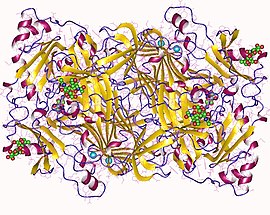Diamine oxidase
| Diamine oxidase | |||||||||
|---|---|---|---|---|---|---|---|---|---|
 Diamine oxidase dimer, Human | |||||||||
| Identifiers | |||||||||
| EC no. | 1.4.3.22 | ||||||||
| Databases | |||||||||
| IntEnz | IntEnz view | ||||||||
| BRENDA | BRENDA entry | ||||||||
| ExPASy | NiceZyme view | ||||||||
| KEGG | KEGG entry | ||||||||
| MetaCyc | metabolic pathway | ||||||||
| PRIAM | profile | ||||||||
| PDB structures | RCSB PDB PDBe PDBsum | ||||||||
| Gene Ontology | AmiGO / QuickGO | ||||||||
| |||||||||
Diamine oxidase (DAO), also known as histaminase, is an enzyme (EC 1.4.3.22) involved in the metabolism, oxidation, and inactivation of histamine and other polyamines such as putrescine or spermidine in animals.
The highest levels of DAO expression are observed in the digestive tract and the placenta. In humans, a certain subtype of cells of the placenta, namely the extravillous trophoblasts, express the enzyme and secrete it into the blood stream of a pregnant woman. Lowered diamine oxidase values in maternal blood in early pregnancy might be an indication for trophoblast-related pregnancy disorders like early-onset preeclampsia.[1] Normally the enzyme is not or only very scarce present in the blood circulation of humans, but it increases vastly in pregnant women suggesting a protective mechanism against adverse histamine.[1] It is also secreted by eosinophils.[2][3] In case of a shortage of diamine oxidase in the human body, it may appear as an allergy or histamine intolerance.[4]
References
- ^ a b Velicky P, Windsperger K, Petroczi K, Pils S, Reiter B, Weiss T, Vondra S, Ristl R, Dekan S, Fiala C, Cantonwine DE, McElrath TF, Jilma B, Knöfler M, Boehm T, Pollheimer J (2018). "Pregnancy-associated diamine oxidase originates from extravillous trophoblasts and is decreased in early-onset preeclampsia". Scientific Reports. 8 (6342): 6342. Bibcode:2018NatSR...8.6342V. doi:10.1038/s41598-018-24652-0. PMC 5910386. PMID 29679053.
- ^ Zeiger RS, Coltesn HR (1977). "Histaminase release from human eosinophils". Journal of Immunology. 118 (2): 540–3. PMID 402420.
- ^ Agúndez JA, Ayuso P, Cornejo-García JA, Blanca M, Torres MJ, Doña I, Salas M, Blanca-López N, Canto G, Rondon C, Campo P, Laguna JJ, Fernández J, Martínez C, García-Martín E (2012). "The diamine oxidase gene is associated with hypersensitivity response to non-steroidal anti-inflammatory drugs". PLOS ONE. 7 (11): e47571. Bibcode:2012PLoSO...747571A. doi:10.1371/journal.pone.0047571. PMC 3495953. PMID 23152756.
{{cite journal}}: CS1 maint: unflagged free DOI (link) - ^ Manzotti, G.; Breda, D.; Di Gioacchino, M.; Burastero, S. E. (2016). "Serum diamine oxidase activity in patients with histamine intolerance". International Journal of Immunopathology and Pharmacology. 29 (1): 105–11. doi:10.1177/0394632015617170. PMC 5806734. PMID 26574488.
External links
- Amine+Oxidase+(Copper-Containing) at the U.S. National Library of Medicine Medical Subject Headings (MeSH)
